Law of Tort: Liability, Fault, Defences, Damages and Psychiatric Injuries
VerifiedAdded on 2023/06/10
|5
|1498
|434
AI Summary
This article discusses the potential liabilities of parties based on negligence or tort law, fault in negligence cases, fairness of defences available in negligence, recovery of damages in relation to negligence, and psychiatric injuries in the law of tort. Relevant laws and cases are explained. Course code, course name, and university are not mentioned.
Contribute Materials
Your contribution can guide someone’s learning journey. Share your
documents today.
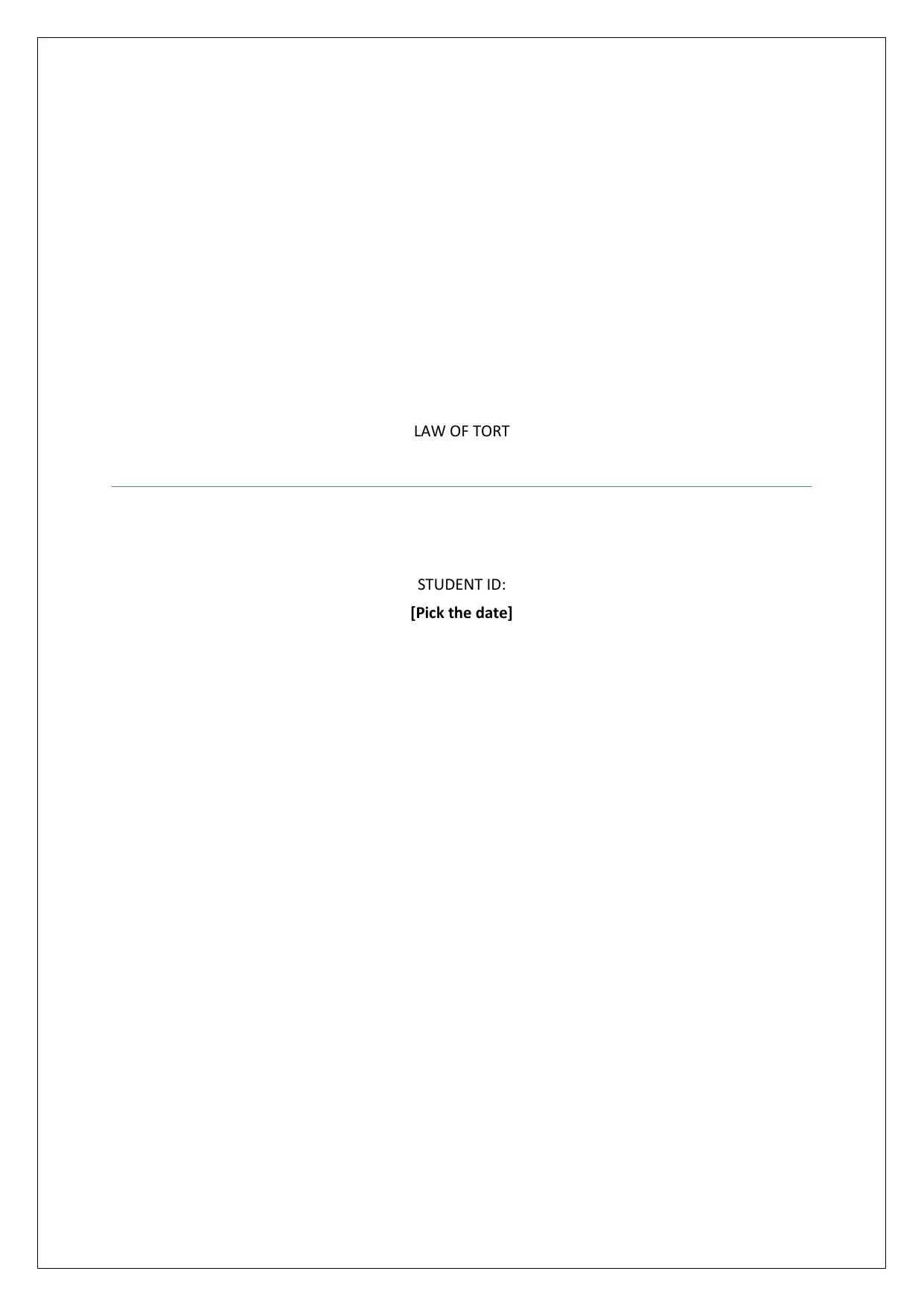
LAW OF TORT
STUDENT ID:
[Pick the date]
STUDENT ID:
[Pick the date]
Secure Best Marks with AI Grader
Need help grading? Try our AI Grader for instant feedback on your assignments.
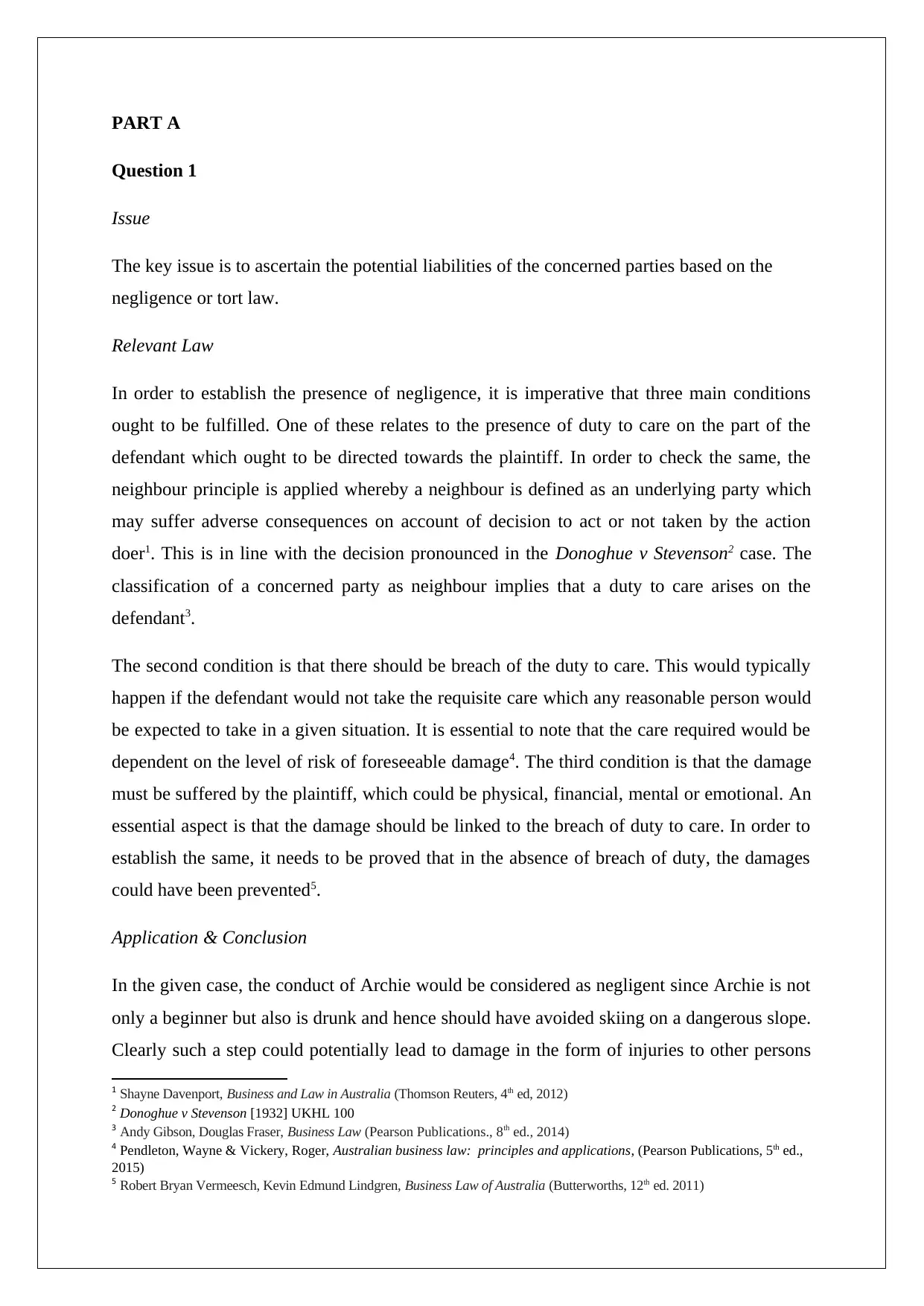
PART A
Question 1
Issue
The key issue is to ascertain the potential liabilities of the concerned parties based on the
negligence or tort law.
Relevant Law
In order to establish the presence of negligence, it is imperative that three main conditions
ought to be fulfilled. One of these relates to the presence of duty to care on the part of the
defendant which ought to be directed towards the plaintiff. In order to check the same, the
neighbour principle is applied whereby a neighbour is defined as an underlying party which
may suffer adverse consequences on account of decision to act or not taken by the action
doer1. This is in line with the decision pronounced in the Donoghue v Stevenson2 case. The
classification of a concerned party as neighbour implies that a duty to care arises on the
defendant3.
The second condition is that there should be breach of the duty to care. This would typically
happen if the defendant would not take the requisite care which any reasonable person would
be expected to take in a given situation. It is essential to note that the care required would be
dependent on the level of risk of foreseeable damage4. The third condition is that the damage
must be suffered by the plaintiff, which could be physical, financial, mental or emotional. An
essential aspect is that the damage should be linked to the breach of duty to care. In order to
establish the same, it needs to be proved that in the absence of breach of duty, the damages
could have been prevented5.
Application & Conclusion
In the given case, the conduct of Archie would be considered as negligent since Archie is not
only a beginner but also is drunk and hence should have avoided skiing on a dangerous slope.
Clearly such a step could potentially lead to damage in the form of injuries to other persons
1 Shayne Davenport, Business and Law in Australia (Thomson Reuters, 4th ed, 2012)
2 Donoghue v Stevenson [1932] UKHL 100
3 Andy Gibson, Douglas Fraser, Business Law (Pearson Publications., 8th ed., 2014)
4 Pendleton, Wayne & Vickery, Roger, Australian business law: principles and applications, (Pearson Publications, 5th ed.,
2015)
5 Robert Bryan Vermeesch, Kevin Edmund Lindgren, Business Law of Australia (Butterworths, 12th ed. 2011)
Question 1
Issue
The key issue is to ascertain the potential liabilities of the concerned parties based on the
negligence or tort law.
Relevant Law
In order to establish the presence of negligence, it is imperative that three main conditions
ought to be fulfilled. One of these relates to the presence of duty to care on the part of the
defendant which ought to be directed towards the plaintiff. In order to check the same, the
neighbour principle is applied whereby a neighbour is defined as an underlying party which
may suffer adverse consequences on account of decision to act or not taken by the action
doer1. This is in line with the decision pronounced in the Donoghue v Stevenson2 case. The
classification of a concerned party as neighbour implies that a duty to care arises on the
defendant3.
The second condition is that there should be breach of the duty to care. This would typically
happen if the defendant would not take the requisite care which any reasonable person would
be expected to take in a given situation. It is essential to note that the care required would be
dependent on the level of risk of foreseeable damage4. The third condition is that the damage
must be suffered by the plaintiff, which could be physical, financial, mental or emotional. An
essential aspect is that the damage should be linked to the breach of duty to care. In order to
establish the same, it needs to be proved that in the absence of breach of duty, the damages
could have been prevented5.
Application & Conclusion
In the given case, the conduct of Archie would be considered as negligent since Archie is not
only a beginner but also is drunk and hence should have avoided skiing on a dangerous slope.
Clearly such a step could potentially lead to damage in the form of injuries to other persons
1 Shayne Davenport, Business and Law in Australia (Thomson Reuters, 4th ed, 2012)
2 Donoghue v Stevenson [1932] UKHL 100
3 Andy Gibson, Douglas Fraser, Business Law (Pearson Publications., 8th ed., 2014)
4 Pendleton, Wayne & Vickery, Roger, Australian business law: principles and applications, (Pearson Publications, 5th ed.,
2015)
5 Robert Bryan Vermeesch, Kevin Edmund Lindgren, Business Law of Australia (Butterworths, 12th ed. 2011)
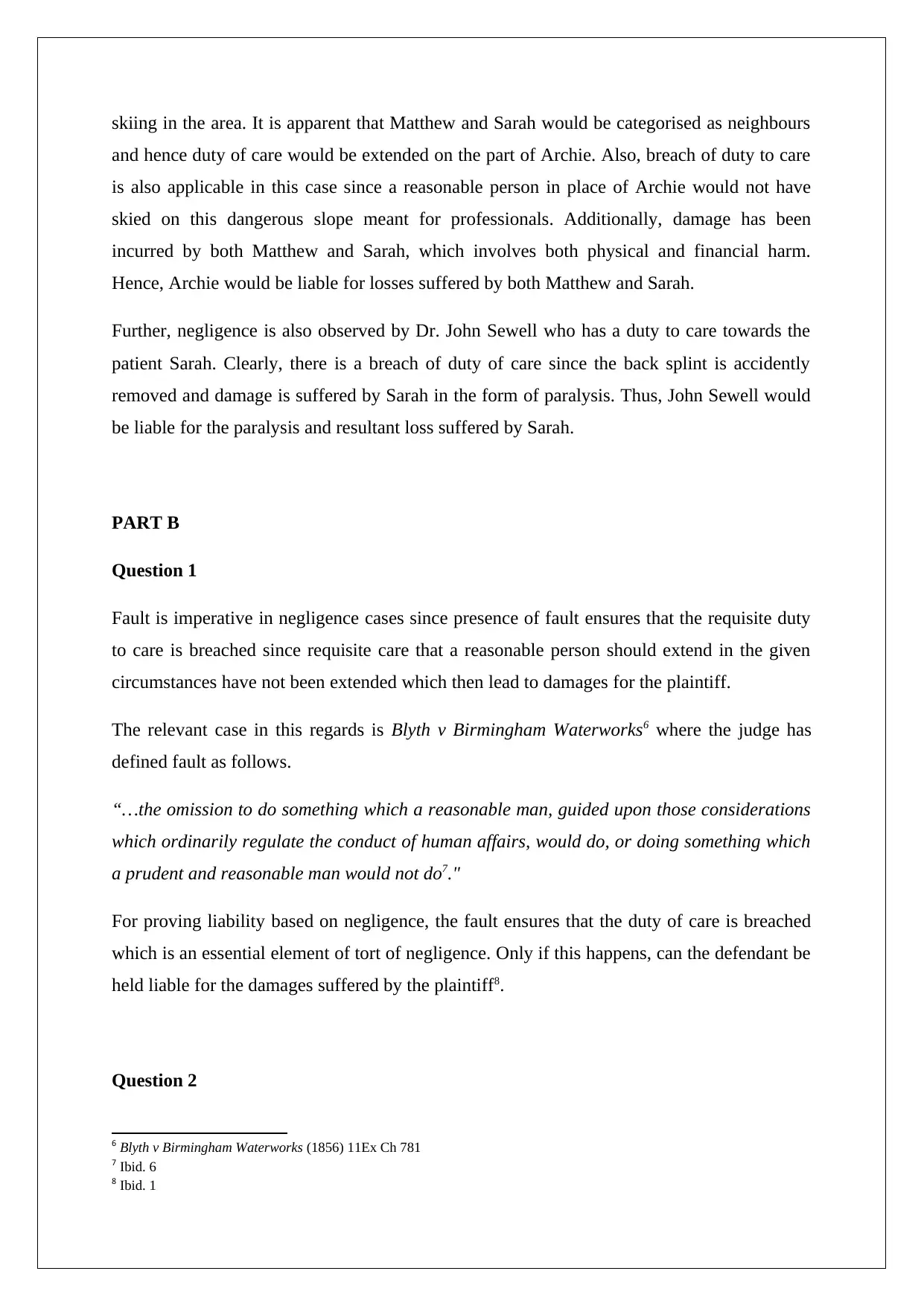
skiing in the area. It is apparent that Matthew and Sarah would be categorised as neighbours
and hence duty of care would be extended on the part of Archie. Also, breach of duty to care
is also applicable in this case since a reasonable person in place of Archie would not have
skied on this dangerous slope meant for professionals. Additionally, damage has been
incurred by both Matthew and Sarah, which involves both physical and financial harm.
Hence, Archie would be liable for losses suffered by both Matthew and Sarah.
Further, negligence is also observed by Dr. John Sewell who has a duty to care towards the
patient Sarah. Clearly, there is a breach of duty of care since the back splint is accidently
removed and damage is suffered by Sarah in the form of paralysis. Thus, John Sewell would
be liable for the paralysis and resultant loss suffered by Sarah.
PART B
Question 1
Fault is imperative in negligence cases since presence of fault ensures that the requisite duty
to care is breached since requisite care that a reasonable person should extend in the given
circumstances have not been extended which then lead to damages for the plaintiff.
The relevant case in this regards is Blyth v Birmingham Waterworks6 where the judge has
defined fault as follows.
“…the omission to do something which a reasonable man, guided upon those considerations
which ordinarily regulate the conduct of human affairs, would do, or doing something which
a prudent and reasonable man would not do7."
For proving liability based on negligence, the fault ensures that the duty of care is breached
which is an essential element of tort of negligence. Only if this happens, can the defendant be
held liable for the damages suffered by the plaintiff8.
Question 2
6 Blyth v Birmingham Waterworks (1856) 11Ex Ch 781
7 Ibid. 6
8 Ibid. 1
and hence duty of care would be extended on the part of Archie. Also, breach of duty to care
is also applicable in this case since a reasonable person in place of Archie would not have
skied on this dangerous slope meant for professionals. Additionally, damage has been
incurred by both Matthew and Sarah, which involves both physical and financial harm.
Hence, Archie would be liable for losses suffered by both Matthew and Sarah.
Further, negligence is also observed by Dr. John Sewell who has a duty to care towards the
patient Sarah. Clearly, there is a breach of duty of care since the back splint is accidently
removed and damage is suffered by Sarah in the form of paralysis. Thus, John Sewell would
be liable for the paralysis and resultant loss suffered by Sarah.
PART B
Question 1
Fault is imperative in negligence cases since presence of fault ensures that the requisite duty
to care is breached since requisite care that a reasonable person should extend in the given
circumstances have not been extended which then lead to damages for the plaintiff.
The relevant case in this regards is Blyth v Birmingham Waterworks6 where the judge has
defined fault as follows.
“…the omission to do something which a reasonable man, guided upon those considerations
which ordinarily regulate the conduct of human affairs, would do, or doing something which
a prudent and reasonable man would not do7."
For proving liability based on negligence, the fault ensures that the duty of care is breached
which is an essential element of tort of negligence. Only if this happens, can the defendant be
held liable for the damages suffered by the plaintiff8.
Question 2
6 Blyth v Birmingham Waterworks (1856) 11Ex Ch 781
7 Ibid. 6
8 Ibid. 1
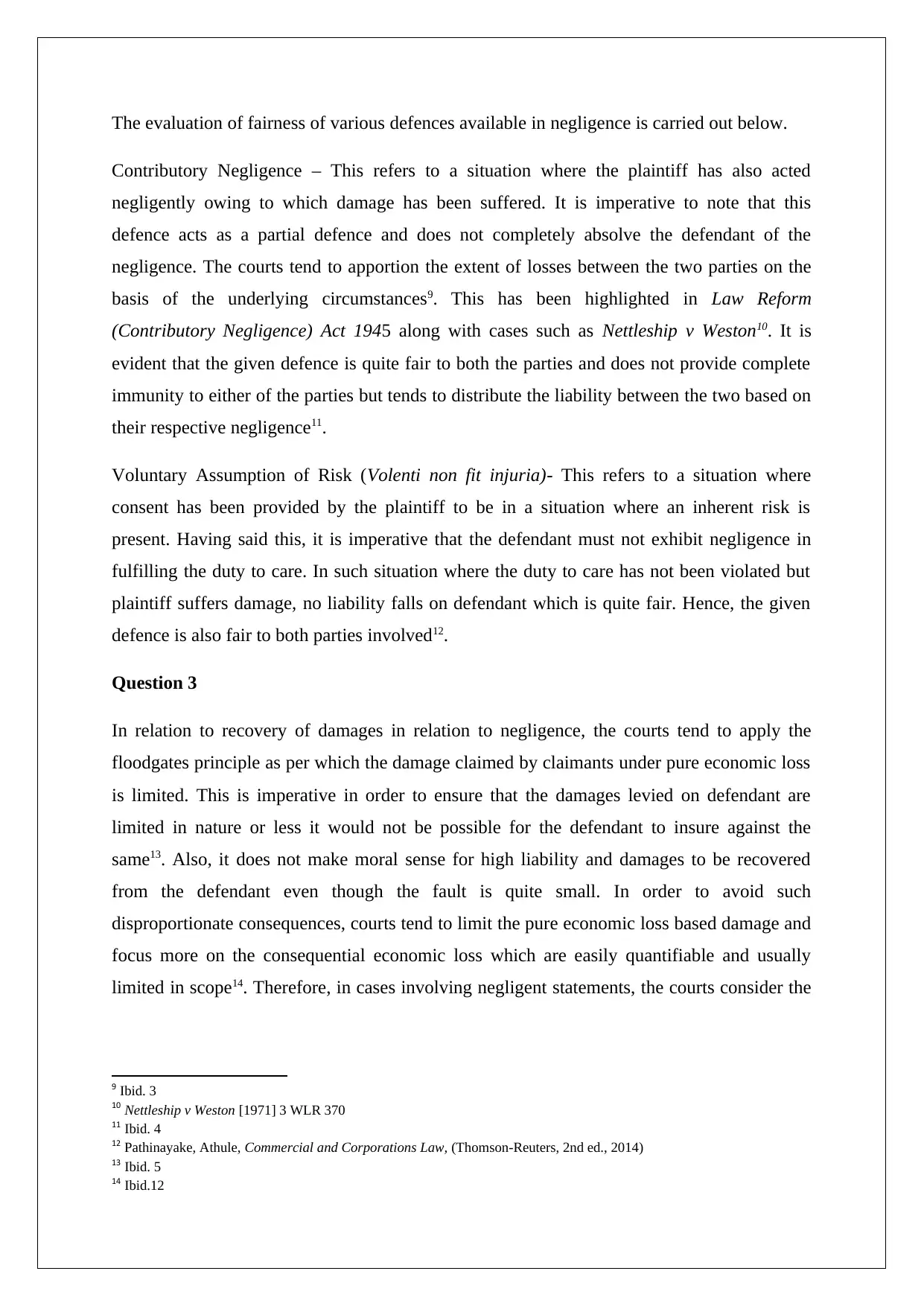
The evaluation of fairness of various defences available in negligence is carried out below.
Contributory Negligence – This refers to a situation where the plaintiff has also acted
negligently owing to which damage has been suffered. It is imperative to note that this
defence acts as a partial defence and does not completely absolve the defendant of the
negligence. The courts tend to apportion the extent of losses between the two parties on the
basis of the underlying circumstances9. This has been highlighted in Law Reform
(Contributory Negligence) Act 1945 along with cases such as Nettleship v Weston10. It is
evident that the given defence is quite fair to both the parties and does not provide complete
immunity to either of the parties but tends to distribute the liability between the two based on
their respective negligence11.
Voluntary Assumption of Risk (Volenti non fit injuria)- This refers to a situation where
consent has been provided by the plaintiff to be in a situation where an inherent risk is
present. Having said this, it is imperative that the defendant must not exhibit negligence in
fulfilling the duty to care. In such situation where the duty to care has not been violated but
plaintiff suffers damage, no liability falls on defendant which is quite fair. Hence, the given
defence is also fair to both parties involved12.
Question 3
In relation to recovery of damages in relation to negligence, the courts tend to apply the
floodgates principle as per which the damage claimed by claimants under pure economic loss
is limited. This is imperative in order to ensure that the damages levied on defendant are
limited in nature or less it would not be possible for the defendant to insure against the
same13. Also, it does not make moral sense for high liability and damages to be recovered
from the defendant even though the fault is quite small. In order to avoid such
disproportionate consequences, courts tend to limit the pure economic loss based damage and
focus more on the consequential economic loss which are easily quantifiable and usually
limited in scope14. Therefore, in cases involving negligent statements, the courts consider the
9 Ibid. 3
10 Nettleship v Weston [1971] 3 WLR 370
11 Ibid. 4
12 Pathinayake, Athule, Commercial and Corporations Law, (Thomson-Reuters, 2nd ed., 2014)
13 Ibid. 5
14 Ibid.12
Contributory Negligence – This refers to a situation where the plaintiff has also acted
negligently owing to which damage has been suffered. It is imperative to note that this
defence acts as a partial defence and does not completely absolve the defendant of the
negligence. The courts tend to apportion the extent of losses between the two parties on the
basis of the underlying circumstances9. This has been highlighted in Law Reform
(Contributory Negligence) Act 1945 along with cases such as Nettleship v Weston10. It is
evident that the given defence is quite fair to both the parties and does not provide complete
immunity to either of the parties but tends to distribute the liability between the two based on
their respective negligence11.
Voluntary Assumption of Risk (Volenti non fit injuria)- This refers to a situation where
consent has been provided by the plaintiff to be in a situation where an inherent risk is
present. Having said this, it is imperative that the defendant must not exhibit negligence in
fulfilling the duty to care. In such situation where the duty to care has not been violated but
plaintiff suffers damage, no liability falls on defendant which is quite fair. Hence, the given
defence is also fair to both parties involved12.
Question 3
In relation to recovery of damages in relation to negligence, the courts tend to apply the
floodgates principle as per which the damage claimed by claimants under pure economic loss
is limited. This is imperative in order to ensure that the damages levied on defendant are
limited in nature or less it would not be possible for the defendant to insure against the
same13. Also, it does not make moral sense for high liability and damages to be recovered
from the defendant even though the fault is quite small. In order to avoid such
disproportionate consequences, courts tend to limit the pure economic loss based damage and
focus more on the consequential economic loss which are easily quantifiable and usually
limited in scope14. Therefore, in cases involving negligent statements, the courts consider the
9 Ibid. 3
10 Nettleship v Weston [1971] 3 WLR 370
11 Ibid. 4
12 Pathinayake, Athule, Commercial and Corporations Law, (Thomson-Reuters, 2nd ed., 2014)
13 Ibid. 5
14 Ibid.12
Secure Best Marks with AI Grader
Need help grading? Try our AI Grader for instant feedback on your assignments.
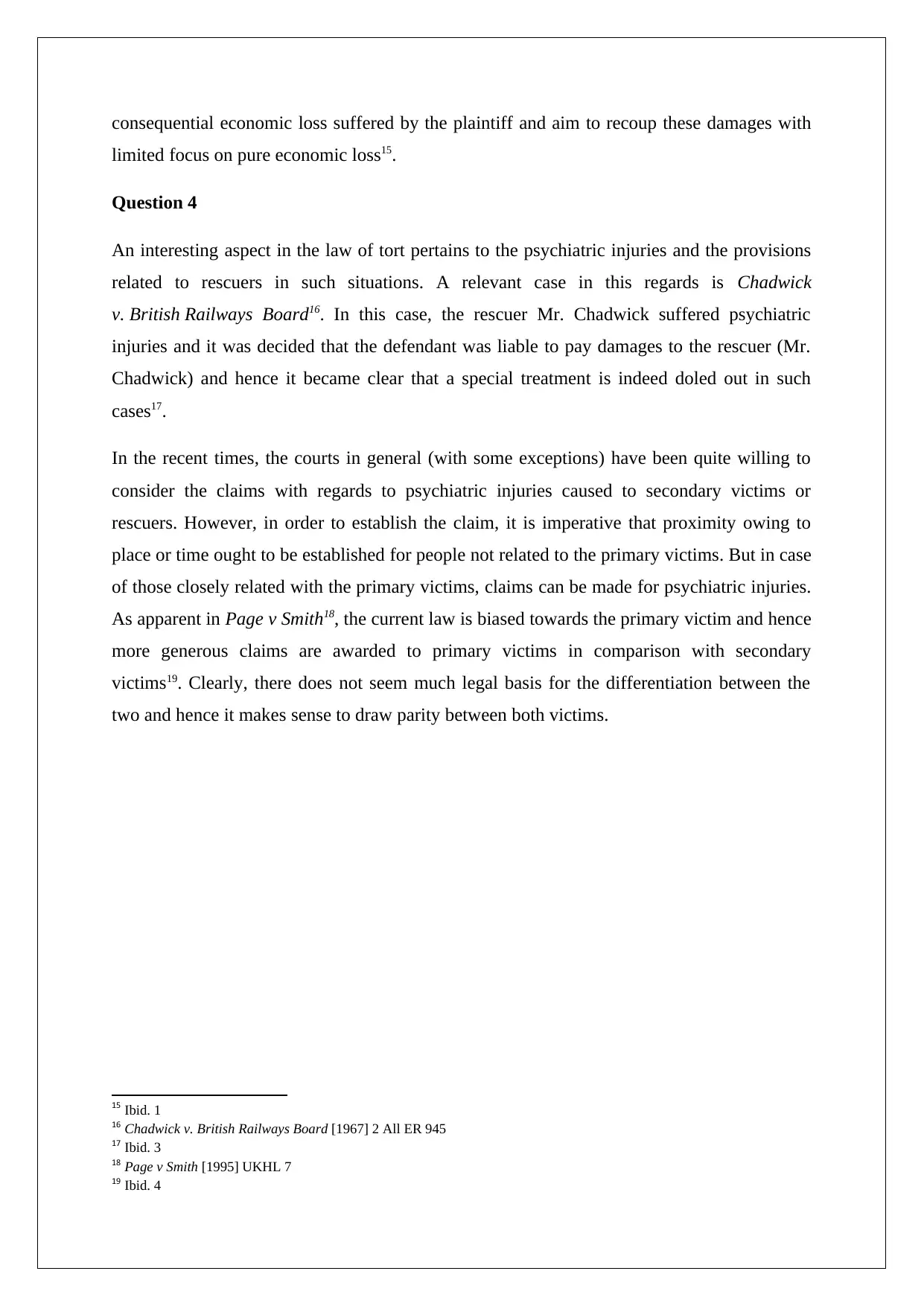
consequential economic loss suffered by the plaintiff and aim to recoup these damages with
limited focus on pure economic loss15.
Question 4
An interesting aspect in the law of tort pertains to the psychiatric injuries and the provisions
related to rescuers in such situations. A relevant case in this regards is Chadwick
v. British Railways Board16. In this case, the rescuer Mr. Chadwick suffered psychiatric
injuries and it was decided that the defendant was liable to pay damages to the rescuer (Mr.
Chadwick) and hence it became clear that a special treatment is indeed doled out in such
cases17.
In the recent times, the courts in general (with some exceptions) have been quite willing to
consider the claims with regards to psychiatric injuries caused to secondary victims or
rescuers. However, in order to establish the claim, it is imperative that proximity owing to
place or time ought to be established for people not related to the primary victims. But in case
of those closely related with the primary victims, claims can be made for psychiatric injuries.
As apparent in Page v Smith18, the current law is biased towards the primary victim and hence
more generous claims are awarded to primary victims in comparison with secondary
victims19. Clearly, there does not seem much legal basis for the differentiation between the
two and hence it makes sense to draw parity between both victims.
15 Ibid. 1
16 Chadwick v. British Railways Board [1967] 2 All ER 945
17 Ibid. 3
18 Page v Smith [1995] UKHL 7
19 Ibid. 4
limited focus on pure economic loss15.
Question 4
An interesting aspect in the law of tort pertains to the psychiatric injuries and the provisions
related to rescuers in such situations. A relevant case in this regards is Chadwick
v. British Railways Board16. In this case, the rescuer Mr. Chadwick suffered psychiatric
injuries and it was decided that the defendant was liable to pay damages to the rescuer (Mr.
Chadwick) and hence it became clear that a special treatment is indeed doled out in such
cases17.
In the recent times, the courts in general (with some exceptions) have been quite willing to
consider the claims with regards to psychiatric injuries caused to secondary victims or
rescuers. However, in order to establish the claim, it is imperative that proximity owing to
place or time ought to be established for people not related to the primary victims. But in case
of those closely related with the primary victims, claims can be made for psychiatric injuries.
As apparent in Page v Smith18, the current law is biased towards the primary victim and hence
more generous claims are awarded to primary victims in comparison with secondary
victims19. Clearly, there does not seem much legal basis for the differentiation between the
two and hence it makes sense to draw parity between both victims.
15 Ibid. 1
16 Chadwick v. British Railways Board [1967] 2 All ER 945
17 Ibid. 3
18 Page v Smith [1995] UKHL 7
19 Ibid. 4
1 out of 5
Related Documents
Your All-in-One AI-Powered Toolkit for Academic Success.
+13062052269
info@desklib.com
Available 24*7 on WhatsApp / Email
![[object Object]](/_next/static/media/star-bottom.7253800d.svg)
Unlock your academic potential
© 2024 | Zucol Services PVT LTD | All rights reserved.





